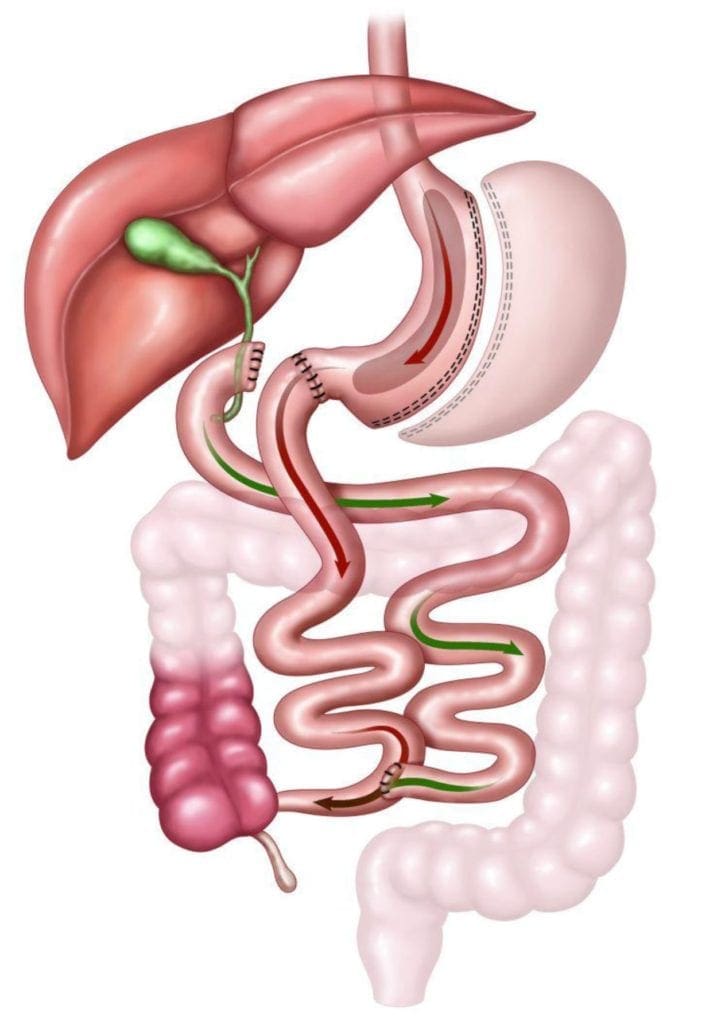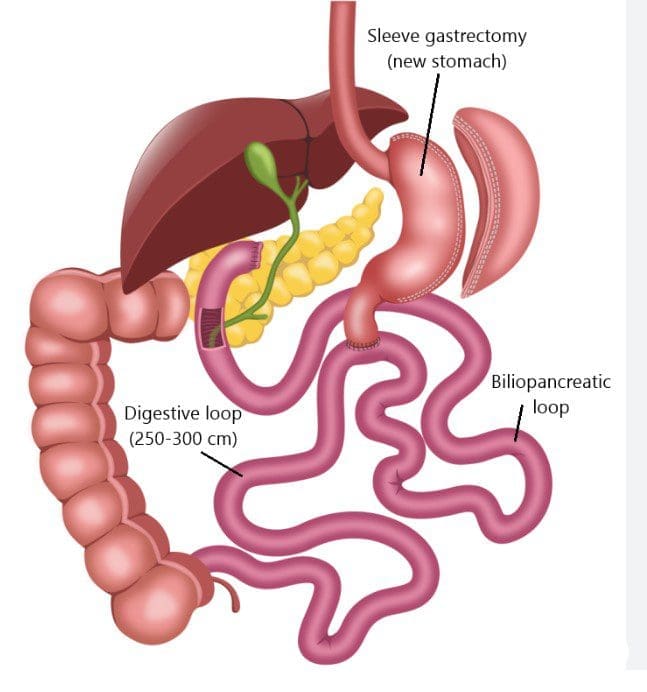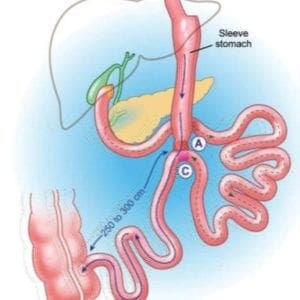The field of bariatric surgery, or weight loss surgery, is always changing. New options seem to come around frequently (and sometimes go away just as quickly). One of the most recent options that has come to the forefront, however, is based on a time-tested procedure that has been around for decades and is likely to stick around. The reason it is likely to stay is simple: it offers great weight loss, similar to the older procedure on which it is based, but it has fewer complications overall.
Gastric sleeve has been around for a while now, so if you need to review the simple anatomy of this procedure just click here. This article will focus on a newer procedure that can be thought of in some ways as a gastric sleeve/gastric bypass mash-up.
This new procedure, unfortunately, does not have a standard name. In fact, at least three different labels have been assigned to it: SIPS, SADI-S, and LDS.
- SIPS: Stomach-Intestinal Pylorus Sparing procedure
- SADI-Single Anastomosis Duodeno-Ileal bypass with Sleeve gastrectomy
- LDS: Loop Duodenal Switch
All of these acronyms refer to the same operation. For the purposes of this article, we will use the name SADI-S. In order to understand the SADI-S, first you need to understand the original procedure on which it’s based: the duodenal switch, or DS.
Duodenal Switch

Five things are done in a traditional DS:
- A loose gastric sleeve is done
- The duodenum (first part of the small intestine) is divided just past the stomach
- The small intestine is divided way downstream
- The distal (far end) of this intestine is pulled up and re-connected to the duodenum up by the stomach
- The proximal (closer end) of this divided intestine is re-connected far downstream, resulting in a very short common channel
The “common channel” is the point where the food you eat gets mixed in with the digestive enzymes coming down from your liver and pancreas. So the DS is very effective for weight loss because of this very short common channel–much shorter than in a gastric bypass, and of course much shorter than a regular gastric sleeve. Of course, in a regular sleeve the common channel is the entire length of the intestine, because none gets bypassed at all. Because of this short common channel, most studies show the DS to have better long-term weight loss results and diabetes remission than any other weight loss surgery around.
SADI-S/SIPS/LDS

So what’s different about a SADI-S? The SADI-S takes the original DS and simplifies it a bit. In a SADI-S, the intestine is only divided one time, just past the stomach in the duodenum. The short stump of duodenum is then re-connected to the side of the small intestine, far downstream. So in a SADI-S pretty much the same thing is accomplished–separating the food from the digestive enzymes. Because the procedure is simpler, though, there are less things that can go wrong with it. Whenever a connection is made between intestine and intestine, or intestine and stomach, there is a risk that the connection could leak. This can be a serious problem, and bariatric surgeons do everything they can to avoid this complication. Since the SADI-S has only one connection that has to be made instead of two, this risk could be cut in half. If we list the steps as before, only three things have to be done:
- A tighter gastric sleeve is done
- The duodenum is divided just past the stomach
- The duodenal stump is connected to the small intestine far downstream
Are there any disadvantages then to the SADI-S versus the old DS? Except for a lower risk of leak in a SADI-S, most studies show pretty much the same results for the two procedures. Some people worry about a problem called bile reflux after a SADI-S, but it doesn’t seem to be a huge problem. Bile reflux could occur in SADI where the duodenum is plugged into the small intestine. Bile from the liver is flowing past this connection, but in the original DS bile is kept completely away from that area.
Most bariatric surgeons are getting away from the DS and moving towards SADI-S. So then, let’s look at the pro’s and con’s of SADI-S as compared to just a gastric sleeve.
SADI-S/SIPS/LDS
Pro’s
- Better weight loss
- Better diabetes remission
- Less GERD issues
Con’s
- More complex procedure
- Longer operative time
- Longer recovery time
- Much higher chance of serious vitamin/nutrient deficiencies
- No good options for revision down the road
- Yearly lab work needed for life
- If you don’t take your vitamins you will get a serious vitamin deficiency!
Gastric Sleeve/VSG
Pro’s
- Simpler procedure
- Can be done as outpatient
- Shorter operative time
- Can be converted to SADI-S or RNY
Con’s
- Post-op GERD rate higher
- Less weight loss
- Lower diabetes remission rate
- Vitamin/nutrient deficiencies rare
From a surgeon’s point of view, I think it makes sense for patients with higher BMI’s to go for the SADI-S. For a patient with a BMI over 60 most surgeons would recommend SADI-S over gastric sleeve. For a patient with a BMI under 50 many would recommend sleeve over SADI-S. 50-60 BMI is a gray zone as there are some patients who can be successful with a sleeve, and avoid all those long-term SADI-S risks. In my opinion, sleeve would be my first choice but I would discuss with the patient that conversion to SADI-S down the road could be necessary.
Another issue to consider is insurance coverage. Many policies will cover the older DS, but not the new SADI-S. This will change with time, though, and more weight loss surgeons will become adept at performing this procedure. So we can expect the SADI-S to not only stick around, but also to become more and more popular with time, given its excellent weight loss results and lower complication rates.

Trace Curry M.D.
Dr. Trace Curry is the medical director of JourneyLite Physicians and JourneyLite Surgery Center in Cincinnati, Ohio. JourneyLite is a multi-specialty center that focuses on advanced outpatient laparoscopic weight loss surgery and incisionless weight loss procedures. He has done over 7000 weight loss procedures in his career and is a key opinion leader in the field of surgical and incisionless weight loss.





